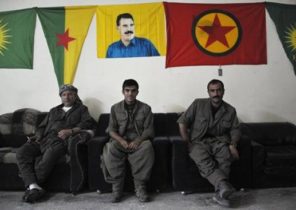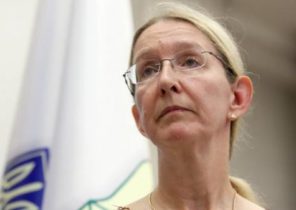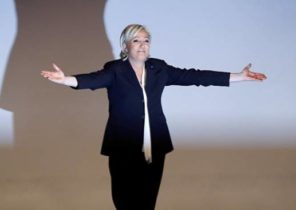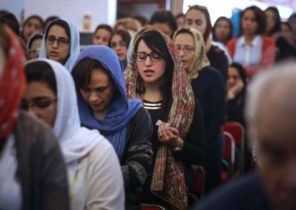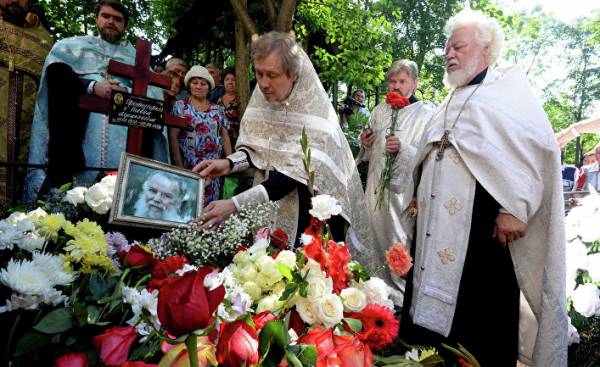
Truck driving on a bumpy road in the direction of the cemetery. Wind flowing hair lying in a coffin male.
This is his last journey.
The coffin placed near the grave, and the wife again leans over the man. She gets out of the pocket of her comb, combs his hair and puts the comb back in his pocket.
Researcher of culture burial, Laura Yates (Laura Jetsu) was present at the funeral in Karelia, where this accident happened.
“It looks very related, individual and unique. Have each family member their attitude to the dead, and he can show it at a funeral.”
Refugees from Karelia brought their traditions in the Finnish culture of the funeral. Now, however, the deceased is no longer driven to the cemetery in an open coffin. However, the dead man remains present at Orthodox funerals, he can be touched and kissing.
Communication with the customs of the old Karelia is manifested in different ways. Yates identifies two custom, which are still present in Orthodox culture: the physical presence of the deceased and the remembrance of him after death.
“The attitude to the dead is expressed openly. The other world is the place where the dead continue to exist in such a form that it is not visible, but exist.”
Three nights near the corpse
Laura Yates studied the burial rites in Russian Karelia in the 90-ies. At that time the Soviet Union collapsed and the Communist party no longer existed. People are instructed how to behave in any situation. It had to do with the funeral.
“People had to act in accordance with their own understanding and based on what they learned from different sources. I wanted to know how people will act in a situation when you have to start all over again. It seems that the role models were searched for in the past,” concludes Yates.
Old traditions and rituals passed down from generation to generation. Connoisseurs of the rituals were old women who decided what and in what order to do it.
“They had that power, of which Church the funeral vested in the priest.”
In the tradition of the Orthodox Church and the ritual of burial in the Republic of Karelia one of the conspicuous features in common, according to Yates, is the physical presence of the deceased.
“The deceased is present, the attitude is expressed openly and directly”.
Lifeless body and a putrid smell. Family and friends gather around the coffin. Grandfather clock ticking in anticipation of the third day.
In the Karelian villages of the 90-ies was not cold morgue, so the body was at home. In Orthodox Karelia the place of the dead was in the best corner of the hut. The deceased put the head in the corner, and in this position he remained for three days.
“In Karelia are seeking to bury the dead on the third day after death. Three days he lay in the hut in the coffin, washed and dressed. For three days he is not left alone. Somebody is next,” says Yates.
It was called a night vigil or night gatherings. The whole family, friends and neighbors gathered around the corpse. During the night of the vigil they ate, sang and remembered the deceased. Yates was also invited to participate in the night vigil around the corpse.
“It was a pretty relaxed and simple moments. People came, greeted each other, sat around the dead man and quietly talked.”
Thanks to the advent of funeral services deceased no more lying in a coffin at home. But the presence of the deceased in the Orthodox funeral possible today.
“The deceased is physically present, as the coffin is opened. The coffin is identified with a dead man, but his presence should be felt. Around him are members”.
An important common feature of both cultures is the farewell to the dead. In the past the coffin was placed on the ground near the grave to say goodbye to the deceased one last time. Nowadays in Finland the coffin, the grave will not open.
“In the Orthodox Church part of the Church ceremony is the farewell. During his dead man say goodbye to relatives first, and then approach him in turn and be baptized everyone”.
In Karelia at the funeral there are all relatives, even small children.
“Children used to see dead. They are not afraid of the deceased because he used to”.
Due to the fact that the world has become more modern, the funeral of the dead on the third day were rare, but not impossible. According to Church historian Riikonen Juha (Juha Riikonen), and in our days it is possible to bury the dead on the third day, if everything is prepared properly. Last year a former teacher Riikonen was buried on the third day after death.
“It is quite possible. But the graphics in modern humans is so dense that the funeral is often tolerated for a week or two.”
According to Yates, in Karelia the 90-ies it was not easy to leave the village, to buy a coffin and other funeral supplies, so they were produced independently for three days.
“If the deceased is warm in the house for three days, especially in summer, of course, it should be buried. Now in Karelia more follow Western customs, but still wish to bury the dead on the third day.”
Open doors and bed
The deceased family member many times commemorated in Karelia and is still commemorated in the Orthodox Church. One of the very important memorial day is still the fortieth day after death.
“On the fortieth day Requiem service is served. These customs persist to this day,” says Juha Riikonen.
Usually, funeral are also on the third and ninth day after death. A memorial service can be ordered after six months or a year after the death and then every year on the day of death or the day of the birthday of the deceased.
According to Laura Yates, 40 days in the culture of the Church means the period between Easter and Ascension. The Bible says that this is the time when Jesus was to his disciples. In Karelia believed that the six weeks or forty days — a time when the dead could return home.
“The door to the house is not closed, the decedent left a place at the dining table, his bed is always made,”.
When the deceased was carried from the house to the cemetery, the road was marked with fir branches to dead found their way home.
“Now that the dead are taken to the cemetery by car and the coffin has to bear only a small part of the way to the grave, cover it with fir branches. It is an old tradition.”
In six weeks the deceased is determined by the place in the afterlife. After that he no longer has the right to go back.
According to old legends, a dead man from the moment of death to burial was in the intermediate state. He no longer belonged to this world, because he had no soul, but has not yet been associated with the spirit world, as he still was on earth.
“With the deceased was associated fears. The body of the deceased was not afraid in the old culture, but from death tried to get rid of”.
The road of death tried to block iron. It was thought that it is so strong that death couldn’t defeat him.
“Back in the 90-ies, when the coffin was taken to the cemetery, some old woman was put in his place with a poker. It was believed that it will protect the residents of the house of death”
According to Yates, various beliefs exist to this day, but they are not manifest.
“Beliefs can manifest themselves in certain circumstances. Some of them are very tenacious”.
Burning nodules
Clothing of the deceased should have holes.
According to Karelian customs when you sew the shroud of the deceased, the filaments are not tied knots. Clothes to sew so that she landed as quickly as possible. Yates believes that this is for two reasons.
“If the knots to tie, clothing easily broken and dead in the afterlife will have the best new clothes because the old is bad and torn.”
The second reason is an important element — water.
Karelia thought that the hereafter is water. To get there, the dead man had to overcome fire flow.
“It was believed that if the clothes the deceased was a knot, he could burn the deceased. This, of course, is absurd, because clothing was all aflame”.
Another option was to dress the corpse in all the world to the other world, he arrived in formal attire. According to researcher Juha Riikonen, departed Orthodox dressed in their own clothes. The fabric knots are gone.
“Old men sometimes even Express your wishes, what they should wear. Clothing usual, but a bit more ceremony.”
Grain and vodka
Grain, biscuits, tea and vodka.
All this still bring in Karelia on the graves. Many Orthodox Finns also bring departed in the world other relatives food. On the graves usually bring grain, pastries, most breads.
“Food intended for the deceased in the afterlife. Of course, it’s not so literally: the dead will not come and will not eat it. It is believed that the souls of the dead arrive at the cemetery in the manner of little birds”.
“Birds are identified with the souls of the dead. When birds eat food, it goes just to the person for whom was intended. In Orthodoxy there is a similar idea.”
On the graves usually bring quite a bit of food. According to Yates, on the Karelian cemeteries you can see the dishes, plates, cups and glasses.
Food is present in the service in the Orthodox Church. When, during the offertory is preparation of the bread and wine for the sacrament of the Eucharist, one of the prosphora is taken out a little bit for the dead.
“This does not mean that the dead should come and eat it, it is done in memory of them.”
According to Juha Riikonen, Finland food on the graves bring quite rare, but in due time he was brought to the cemetery of bread and fruit. In Finland often bring flowers. This custom has spread in Karelia.
“Sometimes I drink vodka,” laughs Riikonen.
Ordinary people in Karelia put a lot of wooden crosses, because the stone was hard to buy. According to Juha Riikonen, wooden crosses are also common in Finland.
Riikonen says that we are talking about sharing a meal. On the grave are usually together and eat food together.
“The same food is divided among all, and the dead in a certain way is also present in this case. The deceased are remembered and make a small prayer”.
In Russian Karelia and Estonia, the graves are visited more often than in Finland. In memory of the dead and the angel days at cemeteries a lot of people.
“Then graveyards are full of people, and spend there many hours,” says Riikonen.
According to Riikonen, the relationship with the deceased a friendly and direct. In Finland some relatives visit the graves of loved ones almost daily.
“Come often, especially the elderly, to talk with the dead about his cases.”
From the customs refused and partially forgot about them
Orthodox cemeteries of Finland and today you can see a log cabin built over the graves, “grobut”. Such burial structures, over thousands of years. Their original function has several interpretations.
“It was believed that the soul of the deceased will live in the hut. Therefore, the house had on both sides two doors for entry and exit. I also believe that this hut was built to protect the grave,” writes Riikonen.
According to Riikonen, a little log cabin back in Finland. In addition, the very popular wooden crosses over the graves.
“In Karelia ordinary people put a lot of wooden crosses, because stone was not available. Over time, wooden crosses fell and was destroyed. The symbolism lay in the fact that everything visible vanishes and dies, only the eternal human soul. People want to return to their roots”.
Adapt old customs to the present day
“Old people talk about existed in Karelia, the customs, but not necessarily that the youth will abide by them, because it is believed that they are not very suitable for today.”
Many of the customs of burial were forgotten when I had to leave Karelia. About 70% of the inhabitants of the parishes moved to Finland, and many of the traditions were forgotten.
“It was thought that in the Lutheran environment of Finland other customs of burial is not understood. Orthodox Christians were considered second-class citizens, many Orthodox people were afraid to talk about their faith,” says Riikonen.
From many traditions refused fully or we just forgot about them. But according to Yates, the attitude towards the dead and his remembrance is preserved in both cultures.
“Regardless of social class, in the old and new cultures there is equally outspoken attitude to the dead. Some quietly preserved the understanding and intuitive knowledge of how to treat a man and act with him,” concludes Yates.

